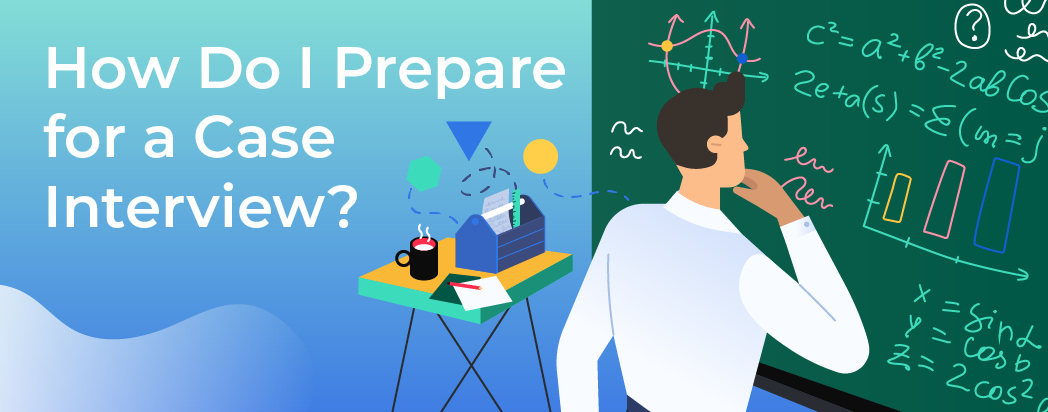
What you will learn:
In preparing for the case interview, there are a few skills and tools that you can master to help you succeed. These tools are at the core of any successful management consultant’s problem-solving process. Learn what these tools and skills are and how you can utilize them to help you perform at your best during the case interview.
Topics Covered:
Case Interview Math
The math concepts involved in a case interview are no different than the ones you use every day: addition, subtraction, multiplication, and division. However, while the core computations are the same, the way that the math is used is very different.
Clients don’t give consultants math tests. They give them business problems that happen to require math to find a solution.
Solving an equation is NEVER the goal in consulting. It is simply a means to an end.
A case interview is the same, it is not a computational test. It is a thinking test that involves computations.
When a Calculation Is or Is Not Needed
The core skill that you need to develop to master is math for consulting, the skill of discerning when a calculation is necessary and when it’s not.
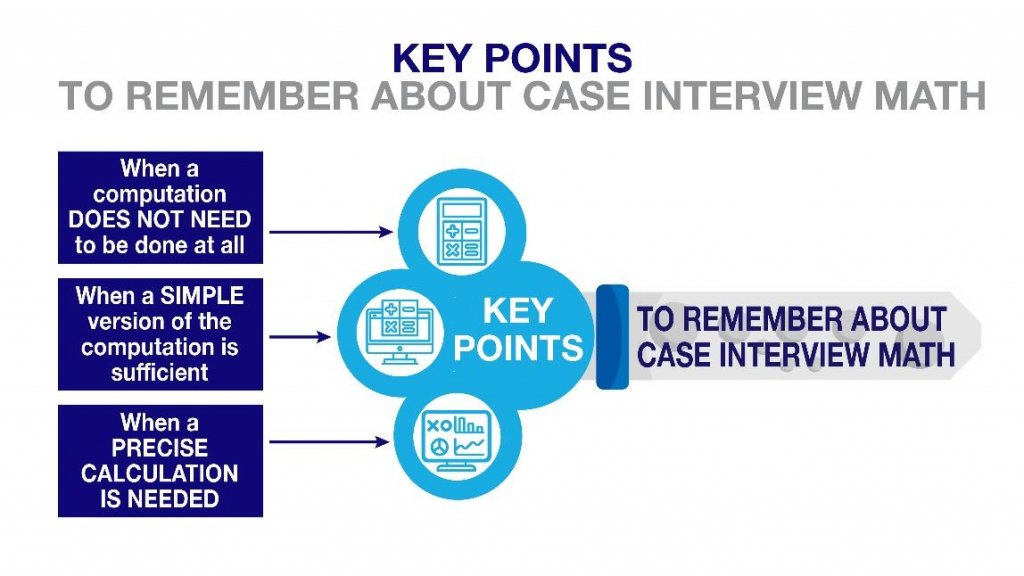
Remember, the challenging part about doing case interview math isn’t always the computation itself. It is about being able to judge whether a computation is even necessary in the first place.
Hypothesis
Hypotheses come from the scientific method, which a scientist uses to test an idea she has about what might be true in our world. Consulting firms have come to favor the scientific method approach when they need to prove a point. And, as noted, this approach starts with the hypothesis.
Because this is the preferred approach consulting firms take when working with clients, it also should be a preferred approach in the case interview.
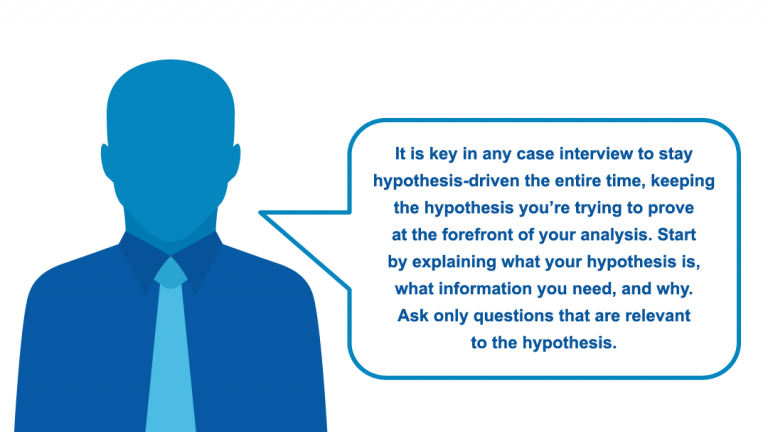
Here is an example of how this might look in a case interview:
Interviewer: XYZ Company’s profits are down 25%.
Candidate: I am going to hypothesize (based on some background information) that the client’s industry is in a price war that has caused the client’s sales and profits to decline. To test this hypothesis, I need to know how the components of the profits have changed since last year. Particularly, have sales or expenses changed since last year?
Interviewer: Sales have remained unchanged and costs have increased by 25%.
Candidate: My conclusion is that my initial hypothesis is incorrect. It looks like the client is facing a cost problem, not a revenue problem. My next hypothesis is… Note how the entire process repeats itself. This is essentially how the case interview would work. The first step is to state the hypothesis. The second step is to decide how you will test that hypothesis (using an issue tree or framework, which will be discussed in the following sections of this guidebook)
Issue Tree
A scientist uses an experiment to test a hypothesis; a consultant uses an issue tree. An issue tree lays out a set of logical conditions that, if proven correct, prove the hypothesis correct. The term “issue tree” comes from the way such a logical structure looks when diagramed on paper – like a tree on its side. Another way to look at an issue tree is as a logical argument that can be tested with data.
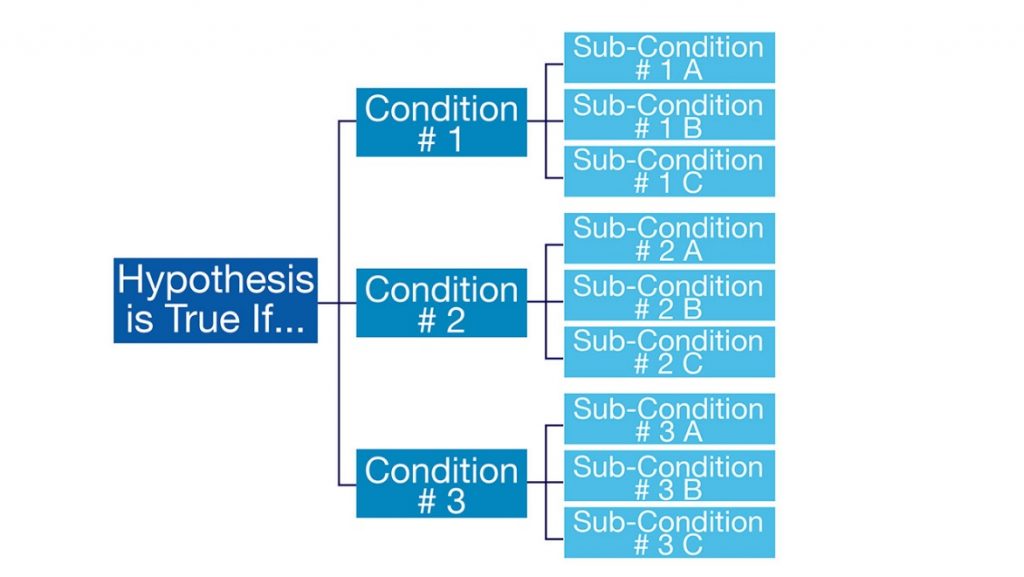
The logic of an issue tree and a hypothesis is analogous to the “if/then” statement common in arguments and proofs:
Issue tree branches = if
Hypothesis = then If these three factors (Branch 1, Branch 2, Branch 3) are true, then the hypothesis is true. The if/then construction provides a clear, logical structure that can be proven or disproven with data. This is the essence of problem structuring using issue trees – you make a logical argument based on the hypothesis that can be easily validated with concrete data.
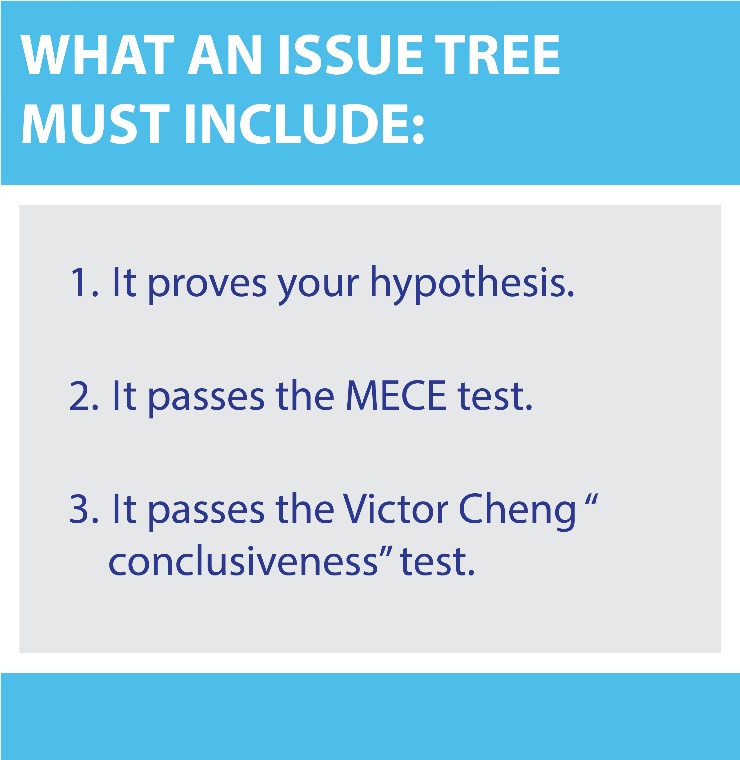
Your Hypothesis
More important than memorizing the main case frameworks is the ability to take your hypothesis and build an issue tree (or customize a standard framework) that will test your hypothesis in this specific case.
The MECE Test
MECE is a principle used by management consulting firms to describe a way of organizing information. The MECE principle suggests that to understand and fix any large problem, you need to understand your options by sorting them into categories that are:
Mutually Exclusive – Items can only fit into one category at a time
And
Collectively Exhaustive – All items can fit into one of the categories
MECE is a systematic framework that helps solve complex problems. By creating an issue tree where each branch represents an exclusive group of factors, you will be able to narrow it down to the single factor that is causing the problem. If there is an overlap in categories, you won’t be able to specifically point out which area the problem is arising from.
To put it simply, a MECE set is one that has no overlaps and no gaps.
The Victor Cheng “Conclusiveness” Test
When looking at your issue tree, say the following statement to yourself: “If all the branches of the issue tree turn out to be true, I can’t imagine a scenario in which the opposite of my hypothesis would be true.” If that statement is valid, then you have a good issue tree that will produce relatively conclusive results.
Let’s take a look at two examples. One example passes the conclusiveness test, and the other does not.
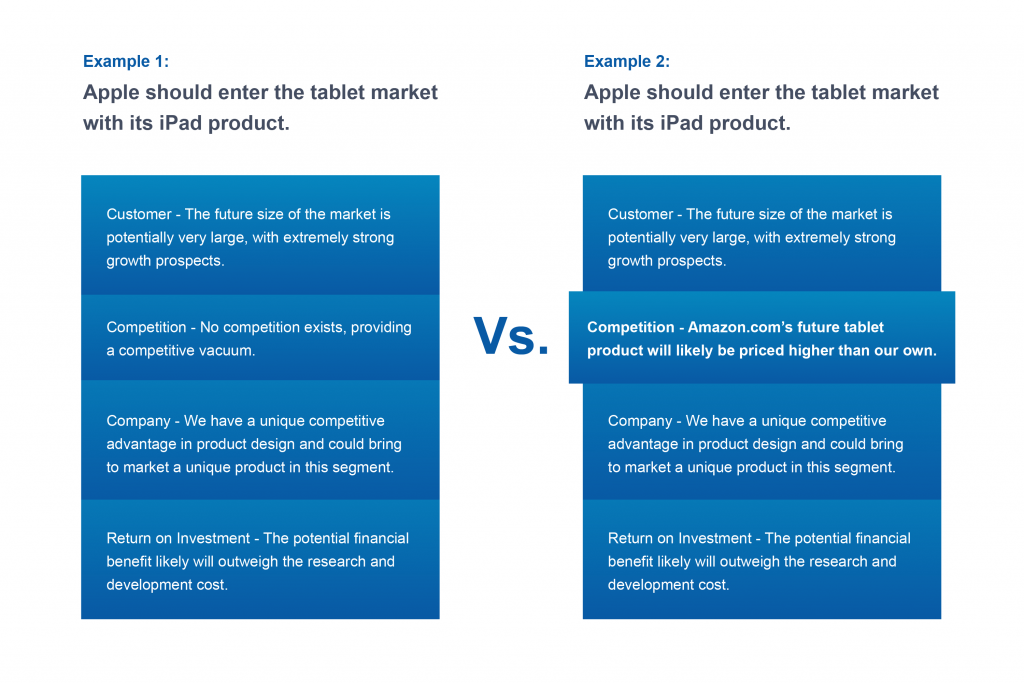
The only factor that changed between these two examples was the competition. In the first example, we can definitively say that, if all of those factors are true, there’s no way that the hypothesis is false.
However, in the second example, even if all of these factors are true, it’s possible that Apple should not enter the tablet market. Maybe Amazon.com’s tablet is going to be priced higher, but it may have features for which people are willing to pay extra. If that’s the case, the competition would have an advantage that could be a real threat to Apple’s success. Ultimately, this test will help you discern:
- Whether you’ve missed any important factors that should be included in your issue tree;
- Whether your issue tree definitely proves your hypothesis;
- Whether you need to remove anything from your issue tree that does not help prove or disprove the hypothesis.
If your issue tree does not fulfill these three requirements, then its validity decreases substantially.
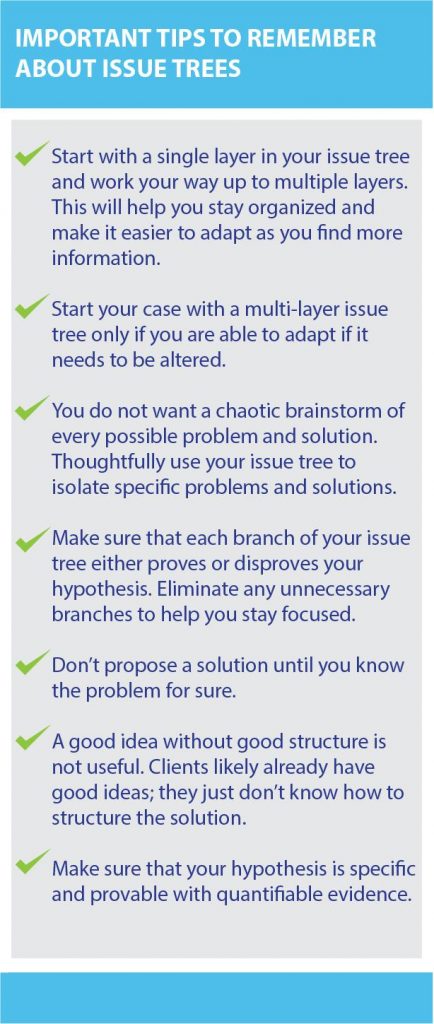
Frameworks
A framework is essentially a template based on a commonly-used issue tree. Because consultants tend to see similar problems among many different clients, frameworks have been developed to deal with these frequently occurring problems.
There is no official list of frameworks in the management consulting industry. Frameworks are simply a way to structure your analysis. Consulting firms often have a set of frameworks that they use for client work, and individual consultants have their own set of frameworks.
The frameworks I used most often as a candidate were the following:
- Profitability
- Business Situation
- Mergers & Acquisitions
These three frameworks, or portions of them, cover approximately 70% of the cases you’ll likely receive.
The Profitability Framework
The Profitability Framework is useful for isolating the mathematical cause of a drop in profits. So, it may be applicable when it is unclear why a client is losing money. It’s an excellent tool for developing a quantitative understanding of the client’s business. But, it is not useful for determining why these quantitative changes are happening.
The Business Situation Framework
The Business Situation Framework is useful for developing a conceptual and qualitative understanding of a client’s business, market, and industry. The strength of this framework is that it helps to uncover conceptual information that provides insight into what’s going on in the case. The weakness of this framework is that it’s not quantitative enough on its own.
The Mergers & Acquisitions Framework
The Mergers & Acquisitions Framework is used to address cases in which one company wants to acquire or merge with another company. It is best used to determine the conceptual “fit” between two companies.
Because this framework is a twist on the above Business Situation Framework, it is also too qualitative in nature and similarly does not quantitatively measure the impact of the qualitative discoveries.
The Case Against Memorizing Frameworks & Placing Too Much Importance on Frameworks Alone
I completely disagree with the school of thought in the case interview preparation community that endorses memorization of 12 or more frameworks rather than the core three above.
The rationale for that approach is that interviewers present different types of cases, so the more frameworks candidates know, the better prepared they are. On paper, this makes sense, but in practice, the approach is flawed for these reasons:
- Insufficient preparation time to learn so many frameworks;
- Lack of mastery of any framework;
- Over-reliance on memorizing more frameworks at the expense of mastering how to formulate a hypothesis and a custom issue tree to test that hypothesis.
This last bullet leads me to my next point.
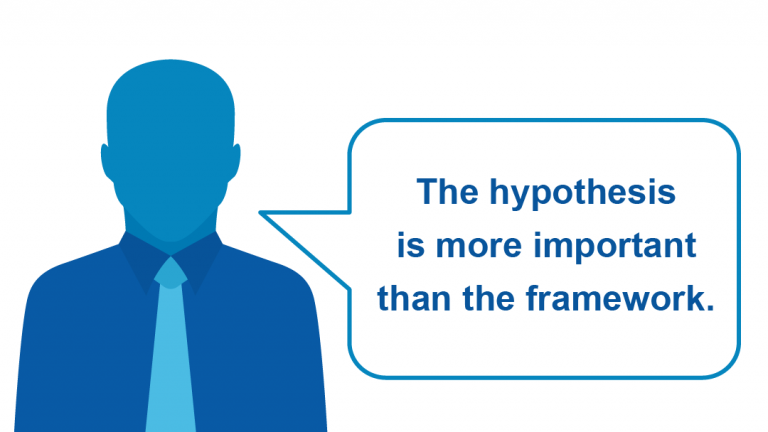
This is true for the simple reason that it is not possible to determine the correct framework until after you have determined your hypothesis.
This is because the case interview process is not a framework-driven approach, it is a hypothesis-driven one. It’s impossible to memorize enough frameworks to cover every case interview scenario. However, you can master three frameworks and develop your issue tree skills to handle anything that the frameworks don’t address.
Synthesis
Synthesis is a way to summarize the information, insights, and conclusions that you have made during a case interview. You use it at the end of a case interview to tell the interviewer what you have learned. You also should synthesize throughout a case interview to show your progress, particularly anytime you switch to a new branch in an issue tree or revise your hypothesis.
Unlike a summary where you recap what has transpired throughout the case, synthesis follows a very specific communication structure:
- Conclusion;
- Reason 1;
- Reason 2;
- Reason 3;
- Restate Conclusion.
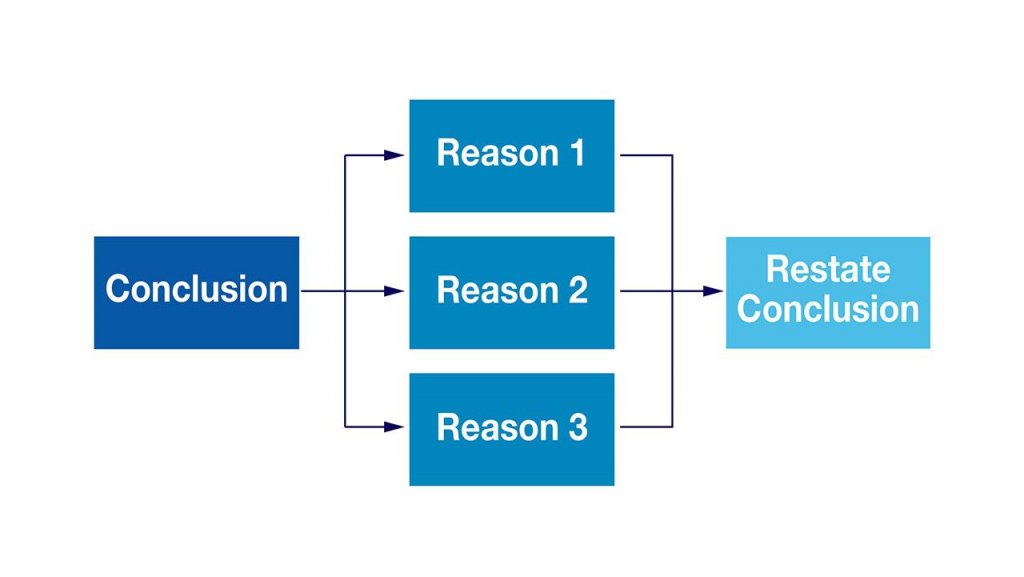
You should only list three reasons. Never more.
The conclusion is always first, always, and should be restated at the end as well.
A synthesis needs to be concise. It needs to be clear what your essential message is. You should have a clear beginning, middle, and end, with an emphasis on the beginning and end.
Interviewers highly value this synthesis communication format because clients value it. Senior clients are extremely busy running a business that potentially makes between $500 million to $1 billion or more a year. Their time is money. If you take, say, 35 minutes to explain something you could have explained just as well in 5 minutes, you have wasted 30 minutes of the client’s time or $50,000 of the company’s money.
Example of Synthesizing in a Case Interview:
Here is an example of how synthesis in a case interview would work.
You are asked to work with a client that had a $10 million profit decline last year. The client wants to fix this. You analyze sales and determine that they remain unchanged from the prior year. We know that if profits have declined but sales have remained unchanged, then costs must have gone up.
There are two ways you could synthesize this:
- “Now that I have analyzed sales, I would like to analyze costs next.”
- “I can conclude that the sales are not causing the profit problem, because 1) sales have remained unchanged in the past year; and 2) costs have gone up by $10 million and account for 100%of the problem. I would like to analyze costs now to better understand which costs increased and why.”
The 2nd example is much better. You remind the interviewer of the problem-solving structure, you firmly conclude what the problem is not, you lead with a conclusion, and you support the conclusion.
Now that you understand the core problem-solving tools of hypotheses, issue trees, frameworks, synthesis and math skills, you must prepare to use these tools in a case interview.
How to Prepare for a Case Interview
Unlike traditional job interviews that ask you about your background and prior experiences, the case interview tests your skillset. It’s not designed to find historical information about your career experiences, it’s designed so that you can demonstrate a skillset in real time in front of a live audience — your interviewer.
Because of that, it does require a lot of preparation in order to be successful and effective in your case interview. There are several important steps to preparing for the case interview:
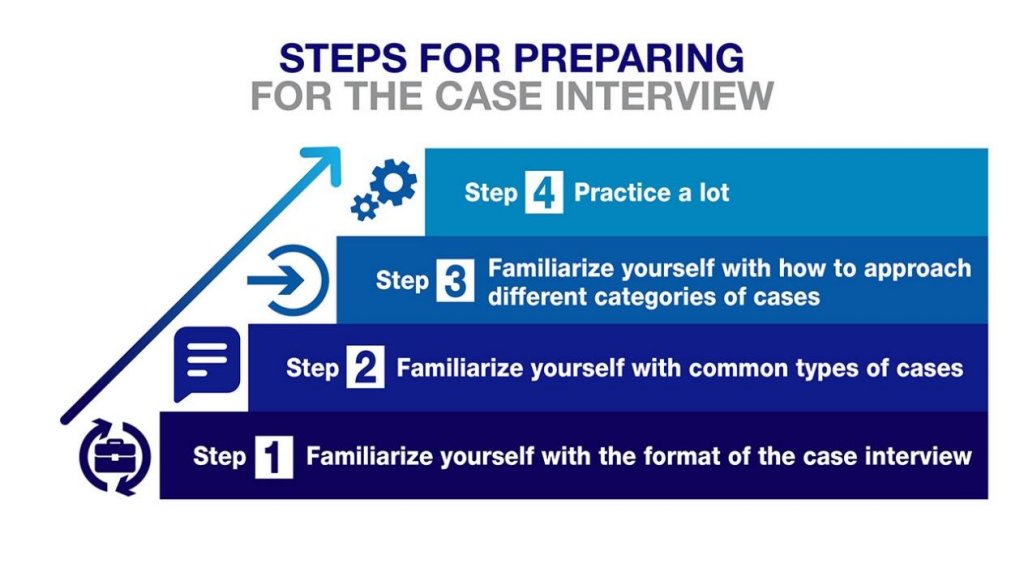
One important thing to note: To ultimately be successful in management consulting, there’s a way of thinking and approaching problems that’s highly valued.
For example, if you work in a top consulting firm and you’re very good at thinking analytically and thinking logically, you’re going to do well. You’re going to get promoted in those firms, particularly if you can prove your ability to think and communicate in a way that’s very client-friendly. You want clients to like and respect you.
A case interview basically is a simulation of that skillset, and that’s what the interviewer is trying to see.
Now, there’s a common mistake that many interviewers complain about. I see a lot of candidates make this mistake. They forget that the interview is a simulation of the real job.
They think the interview is some arbitrary, sadistic, mental exercise designed to torture candidates. It’s just something that you have to pass in order to do the real work. In reality, the case interview is a simulation, a time-compressed version of the real work. Stop and look at everything that you do in a case interview. Focus on how it translates into actual client work.
Another mistake I see a lot of candidates make is that they try to memorize case interview frameworks.
You’ll see lots of frameworks out there, including my own. Be careful with them. The value of a framework is to learn how to think analytically while solving certain kinds of business problems.
When you get good, you don’t want to follow the framework to the letter. You want to understand the underlying principles behind the framework and then apply them in a custom manner to the business problem that you’re facing in the case interview.
Frameworks are like recipes. The interviewers do not want you to memorize the recipe and just recall it during the case interview. This is not a memory recall assessment. It is a way-of-thinking skill assessment.
What the interviewer wants you to do is to use the underlying principles of analytical thinking and apply them to the specific situation. If chefs had a case interview process, they wouldn’t be asked to recall a specific recipe. They would be asked to cook something given particular ingredients.
You can’t use a memorized recipe because the scenario is too specific. It doesn’t matter which recipe you happened to memorize. But, if you know how to cook, you know that cooking has certain principles.
You always need heat. You always need some kind of oil or fat to cook in. You some kind of seasoning. You need a base ingredient like meat or a particular vegetable. You need accent flavors, such as herbs and seasonings.
Just as there are underlying principles behind cooking, there are underlying principles to analyzing business problems.
The key is to learn from the frameworks, see underlying insights, understand why they work and the purpose behind them, and then ultimately ignore the frameworks, create your own, or modify them to fit a specific situation.
I’ll give you a great example. I have many students who say that they memorize all of my frameworks. They practice them a lot, and somewhere in the practicing process, usually around 30 to 50 hours in, something clicks for them.
They finally get why the framework exists. Then, they throw away the frameworks entirely and they start to just think their way through these case situations. I had that personal experience. I have many students who got multiple offers from multiple firms. The top firms express this sentiment as well.
Again, the key thing is that it’s not a framework memorization test. It is a test to assess the way that you think.
The frameworks are a common approach to thinking. But, you don’t want to use them verbatim. Some frameworks don’t always apply to the specific situation that the interview is presenting. In other words, the frameworks are very general and very broad. The problems you’re being presented with are usually more specific.
It’s important that you aren’t overly attached to the framework. Rather, you need to understand why the framework exists so that you can gather certain kinds of data that are relevant. As you figure out what data is relevant, you have a better idea of what’s going on. Once you reach that stage, you can better understand which parts of the framework don’t apply.
So, that’s important to realize.
In terms of practice, you need to practice a lot. You need to practice the case process individually and with somebody else if you can. Try to find a case interview partner or a case interview coach because there is a social aspect of the case interview.
Frankly, it’s a little bit stressful.
For example, there’s math in case interviews. If I give you a math question, say, “What’s four plus four?” You know it’s eight. But, if I give you a more complex math problem, and I stare at you while you solve it, you may feel a little self-conscious.
You have someone trying to make eye contact with you. You’re trying to maintain a dialogue while doing analytical work. It’s more difficult.
It’s important that you practice this social aspect. Interviewers will ask you questions. They’ll challenge you. They’ll disagree with you. They’ll ask if you are sure about that answer. They’ll give you a new piece of information. It’s very interactive.
It’s important that you practice that interactive aspect of the case interview. You need to be accustomed to receiving questions, prompts, interruptions, and new data. You have to be able to have a dialogue, much like you would if you were working with a client.
Clients ask you questions. Clients interrupt you. Clients say, “Well, there’s this other piece of information. Have you thought about that?” Then, you have to incorporate it in real time.
This is all a simulation of interacting with clients.
The key things to understand are the basics of a case: the categories of cases, the frameworks, and how to approach certain cases, then practice them a lot.
As you get good with the frameworks, you can be less reliant on them. That would be ideal.
Interviewers often complain that too many candidates asked them the same exact questions that are listed on the framework.
These candidates aren’t actually listening to the answers that they are getting from the interviewer. They get new data and information, but they aren’t changing their line of questioning.
Adjusting your line of questioning based on new information is a vital skill to demonstrate in a case interview. Here’s why:
If you present a question to a client, they give you data, then you ask questions that do not reflect the new data, the client would think you’re playing dumb. They may think that you’re not paying attention to them, and they may be quite offended.
In the case interview, the framework helps you get started on the case. It’s very useful for the first few minutes. But, it becomes less useful as you progress. The data that the interviewer gives you should change your line of inquiry and your line of reasoning.
The client would expect you to be thoughtful about the information that you’ve received from them. When you don’t adjust your questions and still analyze in the exact same way as if you had no new data, it shows the client that you’re not really paying attention to their situation.
It’s important to recognize that.
In the next section, you will learn how to practice the concepts that I have discussed so that you can perform at your best during the case interview.
Additional Resources
If you found this post useful, I suggest becoming a registered member (it’s free) to get access to the materials I used to pass 60 out of 61 case interviews, land 7 job offers, and end up working at McKinsey.
Members get access to 6 hours of video tutorials on case interviews, the actual frameworks I used to pass my interviews, and over 500 articles on case interviews.
More Topics :

How to Get an Interview
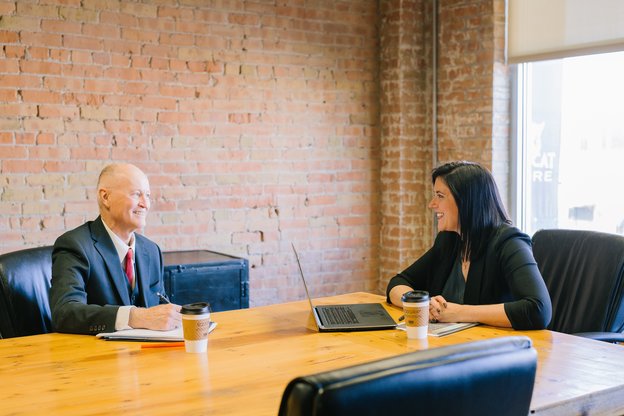
What Interviewers Look For

Case Interview Prep Resources
